Support
Breadcrumb
Product FAQ
The quickest and easiest way to find answers to your questions is searching our Frequently Asked Questions by product.
If your question is not included in our FAQ yet, please contact our Support Team and help us to improve our FAQ list for future use.
Can I charge the base unit with the USB cable to my computer?
The fastest way to charge the base unit is to use the supplied charger. You can also charge with a USB cable connected to a computer or a USB charger, but this will take longer.
Why are my measurements not in the X2 Base Unit?
If you cannot find your measurements, check the setting for Time and Date in the X2 Base Unit. If the date is off, your measurements are stored with a different date and time than expected. To find your measurements, backtrack from the date that is currently displayed.
Adjust the date in the base unit. Measurements made from now on will be stored with the correct date. Measurements stored before the adjustment will keep their old date and time label.
Where is the active sensor area on the different X2 sensors?
The region inside the dashed red line is the active sensor area.
Note: Keep the active sensor area and its surroundings clean and free from stickers. Added material in the X-ray field may affect the measurement result.
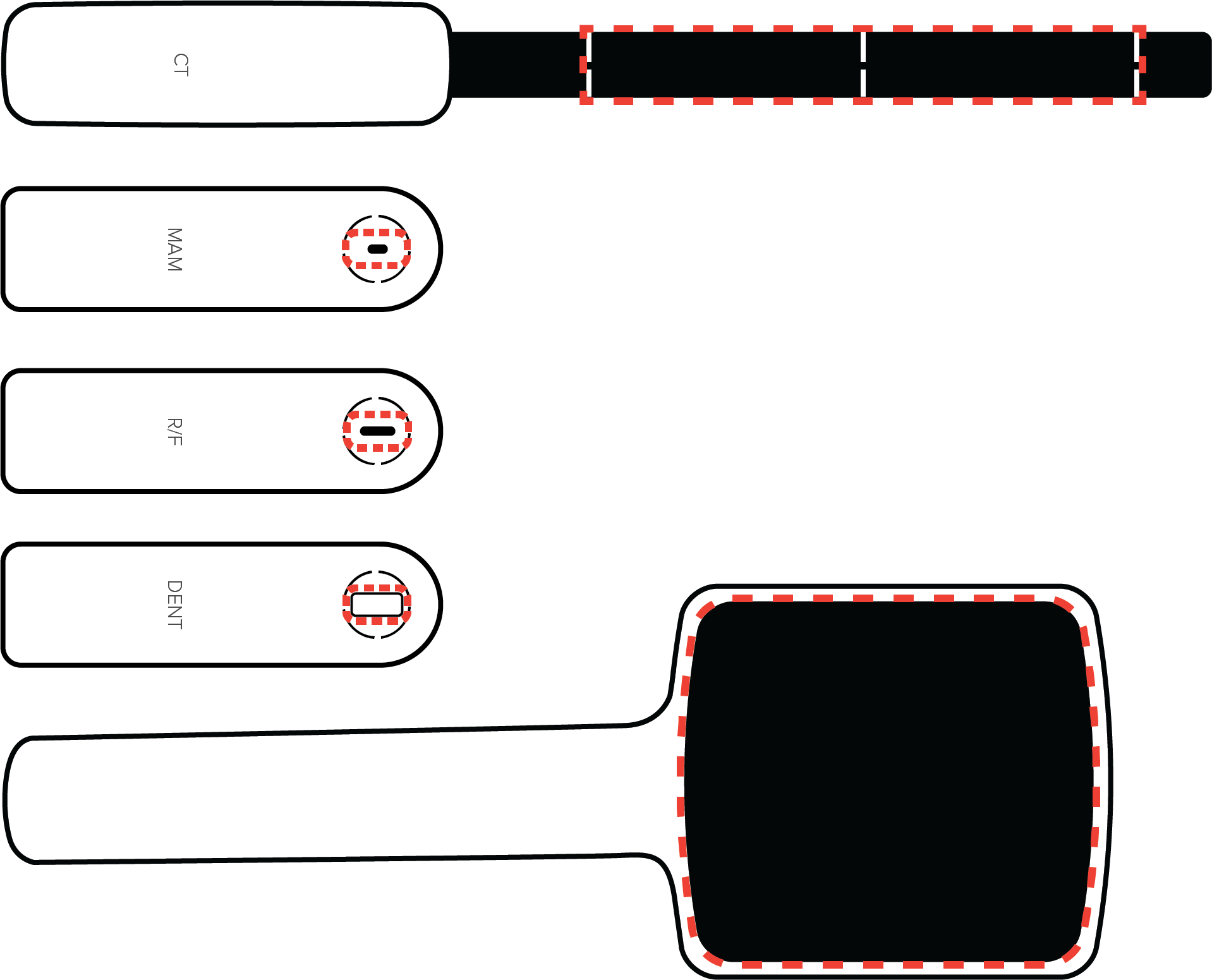
I want to measure on a panoramic dental X-ray machine. Any advice?
Panoramic dental machines can be challenging to measure on, primarily since the X-ray beam is narrow. Therefore, the positioning of the active sensor area is crucial.
- Use the DENT or R/F sensor.
- Position the sensor in the exact center of the X-ray field, where you have the highest dose.
- Sensor positioning is sensitive down to 0.1 mm. Use the RaySafe X2 panoramic holder to slide the sensor horizontally with high precision. Each mark on the scale represents 0.2 mm.
For details on how to use the panoramic holder, see the instruction video.

Is X2 MAM suitable for all mammography machines?
Yes, all common mammography machines are supported. Just connect the X2 MAM sensor and measure to get dose, HVL and time on any beam quality. If you also want the tube voltage (kVp), you must select an anode/filter combination. Swipe left from the home screen to select.
Take a look in the Mammography coverage table to see which anode/filter combinations the X2 can give a kVp value for.
I cannot find my user manual. Where is it?
The user manual for X2 is called “Help” and is integrated in the base unit. Press the menu button on your base unit and then “Help” to see the user manual for your system. You can also find video tutorials and pdf-manuals on the product page.
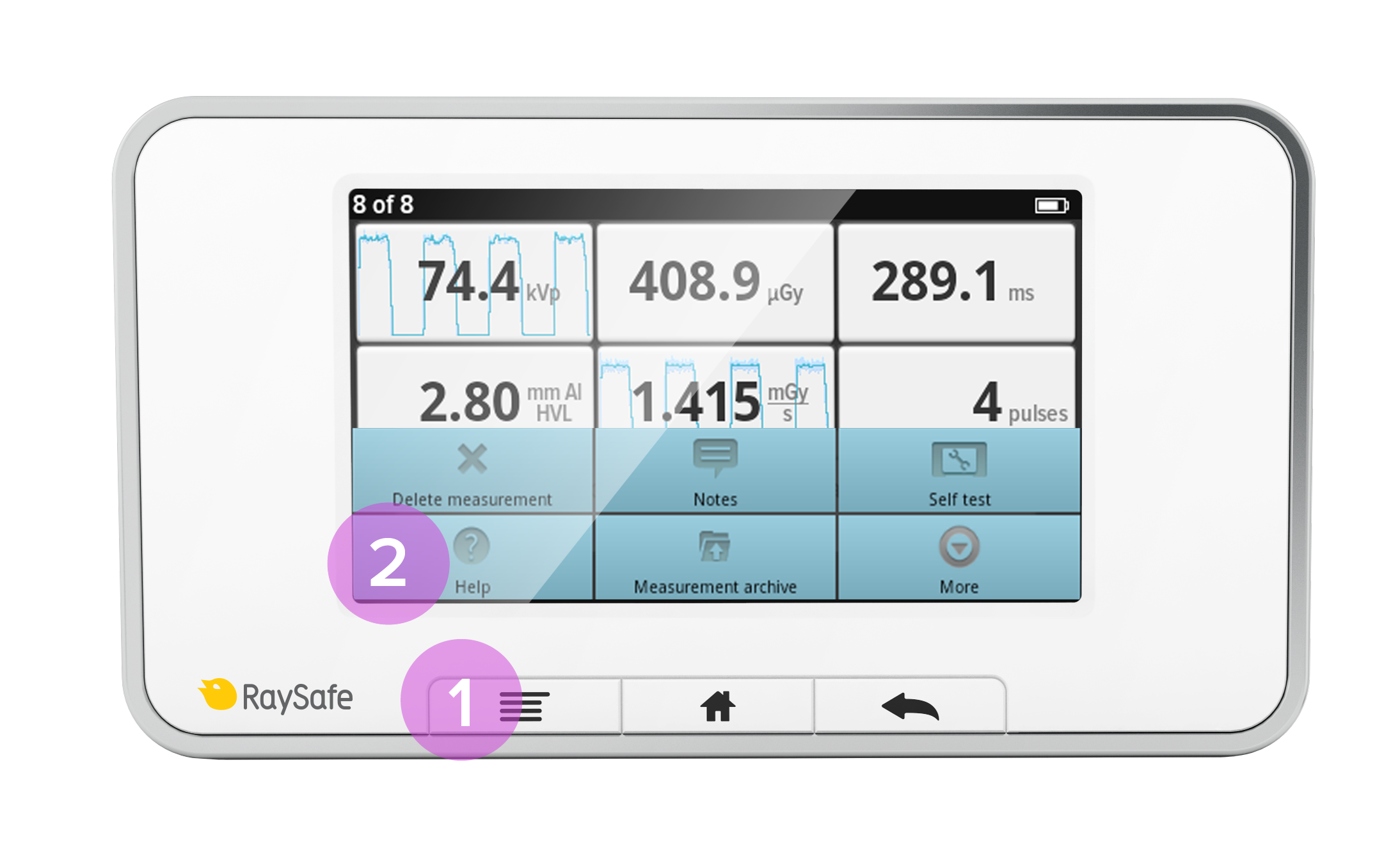
How do I measure with X2 on an AMX4+?
Position and measure as usual. The X2 has full AMX4+ support.
Where can I find previous measurements?
The X2 Base Unit can store several thousands of measurements.
- Swipe down from the home screen to see previous measurements.
- If the base unit has been turned off, or if you have switched to a different sensor, look in the measurement archive: Press the menu button and then Measurement archive. Select the session you want to take a look at.
- You can also use RaySafe View on a computer and select Import from Base Unit in the File menu and select from the calendar. See the RaySafe View manual for more details. Download RaySafe View software.
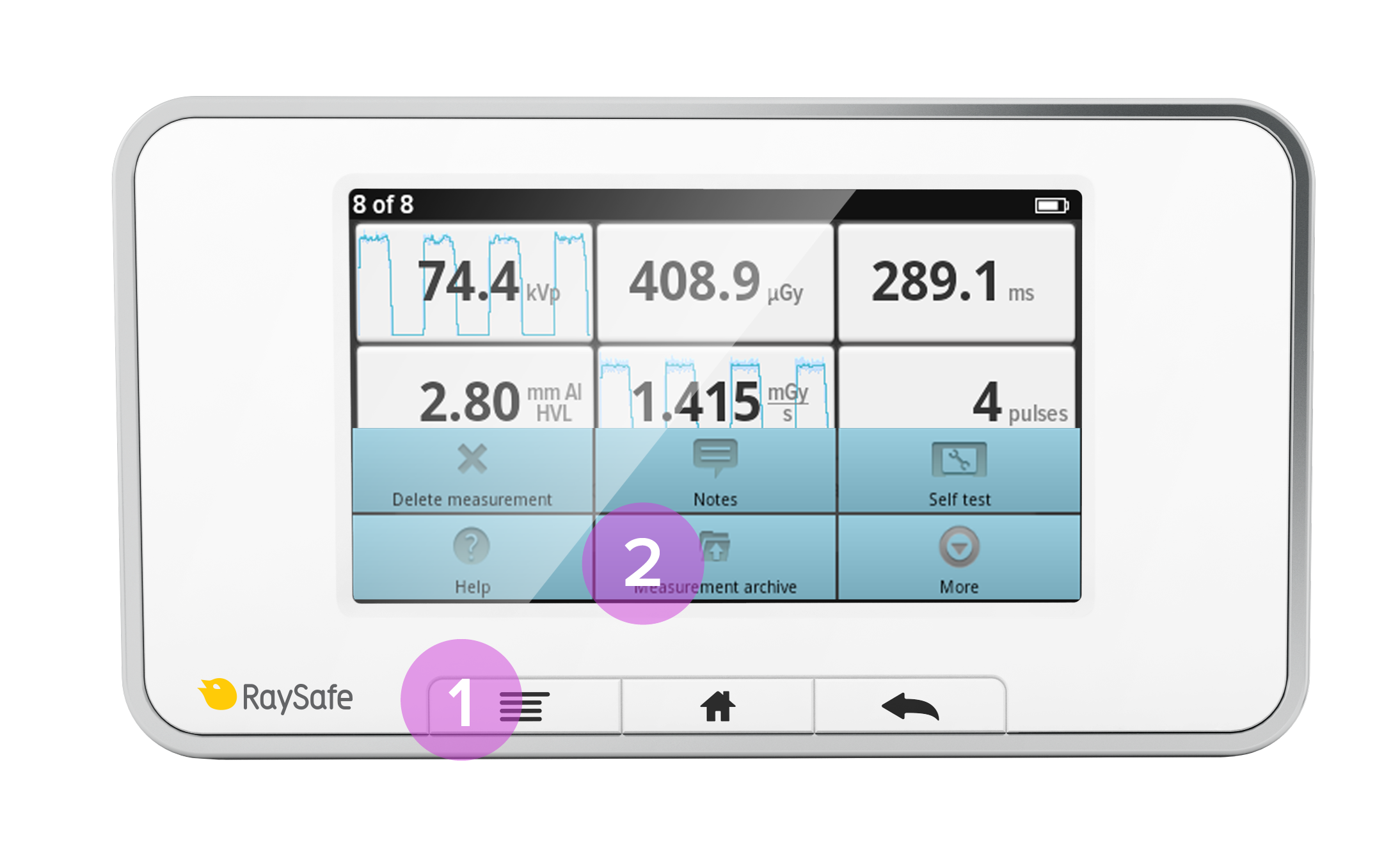
What do the symbols on the Light sensor wheel mean?

Display: Luminance mode. For contact measurements on a display or view box.
0: Zero adjustment.
Light bulb: Illuminance mode. For measurements of ambient light or intensity from a collimator lamp.
How do I view waveforms in full screen on my base unit?
Press the desired parameter from the home screen to go to full screen mode, then swipe left for the waveform. Waveforms are available for kVp, dose rate and mA.
I want to use my Xi View Excel templates with X2. Is that possible?
The default Excel export format in X2 View is compatible with Xi View.
How do I change unit for dose measurements?
Swipe right from the home screen to access the setup. System language is found under X2 Base Unit. You will be asked to restart the base unit for the setting to take effect.
I have problems with my RaySafe X2 Bluetooth connection. What can I do?
- On the base unit side, use the Bluetooth device with USB connection that is provided by RaySafe (Laird BT820, pn: 1922064).
- On the computer side there are various reasons for unstable Bluetooth connection such as incompatible hardware/software or environmental radio disturbances during measurements. Try turning off any programs on the computer that may interfere with the Bluetooth connection.
- If the problem persists, you can try using a RaySafe Bluetooth USB device on the computer side as well. Turn off the internal Bluetooth.
Why can’t I measure kVp on all beam qualities with my MAM detector?
It is enough to measure kV for one beam quality per machine, since the set kVp is independent of anode material and filtration. The Mammography coverage table lists what you can measure on different machines.
When I connect the CT detector I don’t get past “Stabilizing …”. What can I do?
Place your CT detector on a flat surface and restart the base unit. Do not touch or move the detector. If the "Stabilizing" message does not disappear within 5 minutes, fill in a Service Request and send the detector for service.
I get “Offset out of range” with my CT detector. What can I do?
"Offset out of range" is shown when the current in the ionization chamber fails to reach a stable level. Please make sure that:
- the chamber is not irradiated during the stabilization or zero adjust phase,
- you are operating the instrument within its specified temperature range (15–35 °C).
If the problem persists, fill in a Service Request and send the detector for service.
I get too low readings with my Light detector. Why?
Remove the luminance tube and ensure that the white illuminance window is clean. You can clean it with a damp cloth. If the problem persists, fill in a Service Request and send the detector for service.
I have problems with my Bluetooth connection on RaySafe Xi. What can I do?
- Read “SETUP OF BLUETOOTH COMMUNICATION” on page 6 in the Xi View User Manual.
- If you have established the Bluetooth communication as described in the User Manual but still have problems, try turning off any programs on the computer that may interfere with the Bluetooth connection. On the computer side, there are various reasons for unstable Bluetooth connection such as incompatible hardware/software or environmental radio disturbances during measurements.
I have connected the mAs cable but don’t get any readings. What can I do?
Check the polarity and try again.
Note: Connecting the mAs cable with the wrong polarity will not damage the generator or the instrument, as long as long as the mAs cable is securely connected.
How do I change the dose unit?
- When the instrument is in measurement mode, press SELECT (long press) until "Waiting... Aborting measurement" is shown.
- In the SETUP MENU, step (short press) to "Dose unit" and press SELECT until units are shown. Step to the desired unit and press SELECT until SETUP MENU is shown. The unit is now changed.
Note: If only Gray (Gy) is available, your instrument has been configured to comply with German regulations where the unit Röntgen (R) is not allowed.
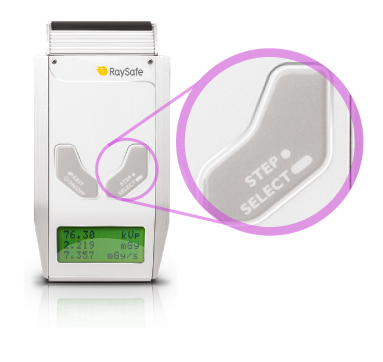
I have problems with the communication between base unit and detector. What can I do?
Check that the cable is properly connected. Try another cable.
What is the difference between R/F high and R/F low, and how do I use them?
R/F high can be used for most measurements and is required for measuring kVp (as opposed to kV).
R/F low is optimized for low radiation intensity, typically during fluoroscopy measurements behind a phantom.
I have problems with the connection between the instrument and Xi View when using USB cable. What can I do?
- Check that you are running the latest version of Xi View and remove older versions from your computer.
- During installation, make sure to tick the box “Install Windows 8 USB driver for serial port adapter”.
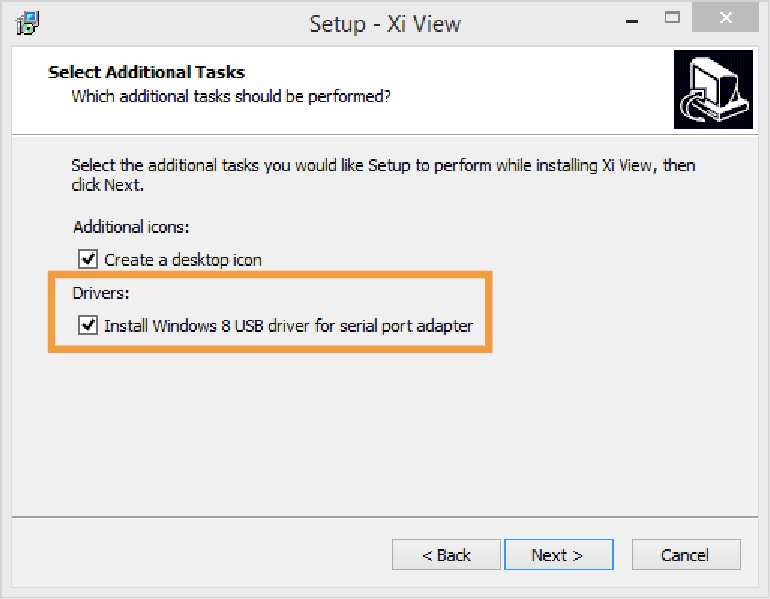
- In Xi View, select ”ATEN USB to serial bridge” in the lower right corner. You may need to re-select it.
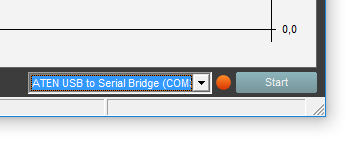
Note: If your Solo instrument came with serial cable and usb-serial converter, it has the PC kit. If you wish to add the PC kit, contact Customer Service.
How do I get kVp on my R/F detector?
The RaySafe Xi calculates kVp on the R/F high sensor if the intensity is high enough (around 10 mGy/s), otherwise kV average will be displayed. If the intensity is too low and you have no possibility to increase the tube current (mA), move the detector closer to the X-ray source.
Note: If your signal level is well above 10 mGy/s and you still do not get kVp, go to the SETUP MENU, select kVp mode, and make sure that kV/kVp is selected.
Why do I get “CRC error” in Xi View when using Bluetooth connection?
CRC error means that part of the data has been lost or altered in transit. This can happen when the distance is too long, or if something is interfering with the signal. Create a clear line of sight between the base unit and computer, or use a shorter distance.
My ThinX shows this screen, why?
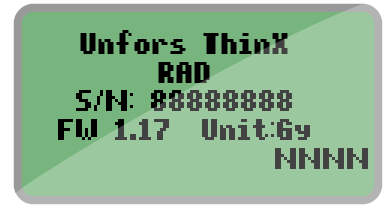
- If you just replaced the battery, this means that your ThinX is starting up. Be patient and wait for a while.
- If the screen appears when you are exposing the ThinX to radiation, you need to replace the battery (model CR2450). Follow the instructions in the user manual: ThinX RAD or ThinX Intra. We recommend using a battery from GP Batteries.
I get an "Instrument error" instead of readings. What shall I do?
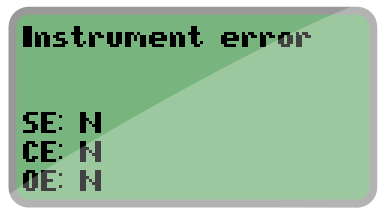
Note: If the error code is "SE:4, CE:0, OE:0", a firmware upgrade is needed. Follow the instructions in the Service Request Form.
Can I change the dose unit on my ThinX?
Yes. Irradiate your ThinX with a sequence of pulses: 3 short, 3 long, 3 short. (Short: <150 ms, long: >300 ms.) The sequence must be performed within 10 minutes. The message "Confirm unit change to Gy?" or "Confirm unit change to R?" is displayed. To confirm, make an exposure of any length within 20 seconds. The message "Unit changed!" is displayed and the ThinX will show values in the new unit. (1 Gy = 114.1 R)
How do I use the DXR+ on mammography machines?
The DXR+ works well placed on the examination table. Use as high kV as possible.
Note: Do not position the DXR+ on top of a magnification table, since the signal is too low there.
Can I replace the battery in the DXR+ myself?
No, you have to send it to RaySafe for battery replacement. Fill in a Service Request to get it done.
Can I use DXR+ for measuring a CT dose profile?
No. The DXR+ has to be irradiated from the printed X-ray arrow and with a continuous field to give a correct result.
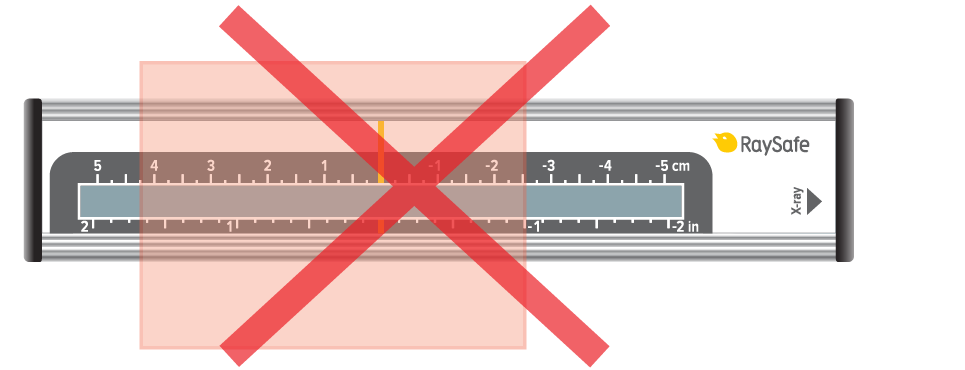
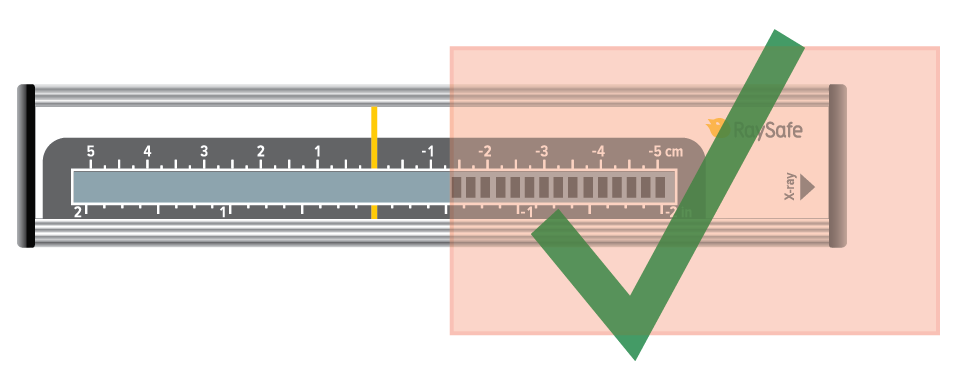
When do I need RaySafe Dose Manager?
Use Dose Manager (optional software) when you want to:
- Compare dose history from several dosimeters at a time
- Retrieve dose history from Real-time Displays via network
- Produce reports
How good is the measurement performance?
The i3 measurement performance is an improvement over the i2, and includes angular reception making it more accurate.
What is RaySafe Dose Manager and what does it do?
Dose Manager is a software installed on your PC to see the history of dose exposures. You can see a dosimeter’s exposure over time and compare it to other dosimeters. With Dose Manager, you can also collect dosimeters exposure history from the Real-time Display and do not need to connect them individually to your computer. Dose Viewer compared to DoseManager can only show information for one dosimeter at the same time, and the dosimeter must be connected directly to your computer when you look at the history.
Do I need to send the dosimeter in for calibration?
No, the dosimeter is designed for maintenance-free usage throughout its lifetime.
Does the i3 have a cradle for connecting the dosimeter to the computer?
No, the i3 does not use a cradle like the i2. The improved i3 design lets you just use a USB cable to connect the dosimeter to the computer.
Can RaySafe Dose Manager be used with the new i3 dosimeters?
Dose Manager can be used with the new i3 dosimeters if you collect the dose information from your Real-time Displays using a network connection or with a USB memory. The i3 dosimeters unfortunately cannot currently be connected directly to Dose Manager by the USB cable.
How long does the battery in the dosimeter last?
The Raysafe Real-time Dosimeter: Approximately 1 year of normal use. The battery can be replaced. See the Installation and service manual for guidance.
The RaySafe i2 dosimeter: Typically 3–5 years, depending on usage. If the battery is out, contact your RaySafe representative or RaySafe Support Contact.
If a part of the dosimeter badge breaks, such as the clip, do I have to replace the entire badge?
The i3 has improved wearability with a replaceable reinforced plastic clip. The i2 has a metallic clip that cannot be replaced.
Can we show the same information as on the RaySafe Real-time Display on any hospital monitor?
Unfortunately, this is not possible with the RaySafe i2/i3. This is something that we look in to for the future but currently only the Real-time Display can be used to visualize the exposure situation in real time.
How do I find the dose history?
- To access the dose history recorded in the Real-time Display, tap on the row for your dosimeter on the display.
- To access the internal dosimeter memory, connect the dosimeter to a computer running Dose Viewer.
The colors distinguishing the badges is helpful but is it possible for us to put names on the badges too?
The i3 has room for naming, whereas the i2 does not.
Can I add i3 badges to my real-time dosimeter system?
Yes, additional badges are available for purchase.
How many dosimeters can be shown at the same time on a RaySafe Real-time Display?
Real-time measurements from up to eight dosimeters are shown simultaneously on the screen. The default order is first come, first serve. If there are more than eight dosimeters in the room, all of them will still measure and accumulate dose, but only the first eight are visible on the display.
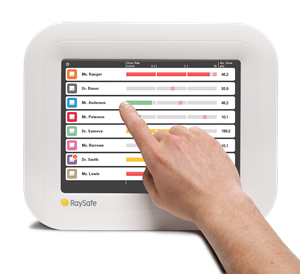
Can I use the dosimeter for measurements in the primary X-ray beam?
No, the intended use for the i3 and i2 systems is to measure scattered radiation only.
Can the RaySafe i2 and i3 be used together with Philips DoseAware?
Yes, they can, i2 and i3 dosimeters will show up on DoseAware base station screens and DoseAware dosimeters will show up on the i2 and i3 base stations screens. As the icons used for dosimeters are not the same for i2/i3 and DoseAware, the dosimeters might however appear differently.
In brief, what are the five best things about the i3 versus the i2?
- Prolonged life cycle
- Improved EMC immunity
- Better measurement specifications
- Automatic sleep mode
- Improved wearability.
Can I install the RaySafe Real-time Display in another room than the lab? What is the communication range of the display?
The real-time display can be installed anywhere, it only needs a power outlet (network connection is optional). The dosimeters communicate with the display via radio. The radio communication range depends on the local environment and the Real-time Display settings (Service Manual) but is normally about 5–15 meters.
Does RaySafe Dose Viewer work with either the i2 or i3?
The Dose Viewer version 1.1.13.0, delivered with the RaySafe i3, is backwards compatible with the RaySafe i2. Older versions of Dose Viewer need to be updated to support i3 Real-time Dosimeters.
How can I update my current RaySafe Dose Viewer application for my new i3 dosimeters?
Please visit www.raysafe.com/products/real-time-dosimetry-systems/raysafe-i3, download and install the latest Dose Viewer that supports i2 and i3 dosimeters.
Does the dosimeter accumulate dose even when there is no RaySafe Real-time Display nearby?
The dosimeter always measures and stores dose data on its internal memory, regardless of whether there is a display in range or not. You can view the dose history at any time by connecting the dosimeter to a computer running Dose Viewer.
To see the dose rate live, the dosimeter needs to be visible on a real-time display. The dosimeter shows up on any Real-time Display within communication range, it is not paired with a certain display.
Is there a difference in the i2 and i3 batteries?
The RaySafe i3 has a customer replaceable battery, which prolongs the product life cycle up to 10 years. The RaySafe i2 badge needs to be replaced when the battery ends in <5 years.
If I update the RaySafe Dose Viewer software, can I still use my i2 badges?
Yes, you can.
What is the difference between RaySafe i2 and RaySafe i3?
The main difference between RaySafe i2 and RaySafe i3 is the dosimeter model:
- RaySafe i3
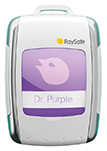
- RaySafe i2
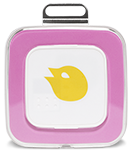
The Real-time Dosimeters (i3) have improved performance in sensitivity and directional response, compared to RaySafe i2 dosimeters. See specifications for RaySafe i2 and RaySafe i3 for details.
Note 1: The Real-time Display works with both RaySafe i2 and RaySafe i3. RaySafe Dose Viewer version 1.1.13.0 or later, delivered with RaySafe i3, is backwards compatible with RaySafe i2. Older versions of Dose Viewer need to be updated to support the new dosimeters (i3).
Note 2: RaySafe Real-time Dosimeters (i3) cannot be directly connected to Dose Manager (optional software) via USB cable. However, you can always use network connection or a USB memory stick to transfer stored dose history from Real-time Displays to Dose Manager.
Is EMC interference, from devices such as cell phones, still an issue with real-time dosimeter badges?
The EMC immunity in the i3 has been significantly improved over the i2, reducing possible interference.
Can I use a combination of i2 and i3 dosimeter badges?
Yes, you can combine i2 and i3 badges but be aware that measurement results may differ. We recommend that you replace the i2 badges with i3 ones as soon as possible to ensure comparable measurements.
